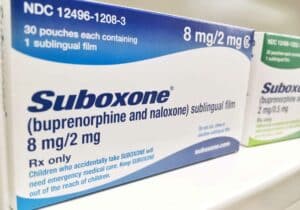Withdrawing from Xanax (alprazolam) can result in serious and sometimes fatal symptoms, emphasizing the importance of medical oversight during the detox process.
In this article, we delve into the symptoms of Xanax withdrawal, highlight the dangers of attempting benzodiazepine detox without professional guidance, and discuss options for obtaining support for Xanax addiction.
What is Xanax Withdrawal?
Xanax withdrawal occurs when the body becomes accustomed to the continuous presence of the drug and struggles to function normally without it. The severity and nature of withdrawal symptoms can differ among individuals, yet there’s a typical progression in how these symptoms unfold over time. People who consume Xanax in larger quantities or for extended periods generally form a deeper dependence, making it harder to cut down or quit and resulting in more severe withdrawal effects. Addiction to Xanax is characterized by the compulsion to keep using the drug in spite of facing adverse effects on one’s life and health.
Xanax Withdrawal Symptoms
The experience of withdrawing from Xanax varies widely among individuals. Studies indicate that up to 40% of users may face severe withdrawal symptoms, while the rest might encounter more moderate effects. The spectrum of withdrawal symptoms includes:
- Anxiety, panic attacks, and hyperventilation.
- Tremors, sleep issues, and muscle spasms.
- Decreased appetite, excessive sweating, and overall discomfort.
- Heightened sensitivity to sensory stimuli.
- Feelings of disconnection and unusual bodily sensations.
- Psychotic reactions such as hallucinations and delirium.
- Risk of severe seizures.
Physical symptoms commonly seen during withdrawal encompass insomnia, fever, digestive disturbances, weight loss, and sensory changes like blurred vision or altered smell. Muscle discomfort, cardiovascular irregularities, and significant changes in temperature and blood pressure are also typical.
Psychological symptoms due to Xanax’s impact on brain chemistry may involve prolonged anxiety, concentration difficulties, mood instability, and in severe cases, delusions or suicidal ideation.
Post-Acute Withdrawal Syndrome (PAWS) represents a prolonged withdrawal phase that might manifest months to years after cessation. Symptoms such as enduring anxiety, sleep disturbances, cognitive impairments, and emotional instability can last from 18 to 24 months, though they generally lessen over time.
Recognizing the range and potential duration of withdrawal symptoms underscores the need for professional support and individualized care in navigating the detox process and recovery from Xanax addiction. If you or your loved one are struggling with Xanax withdrawal in Chattanooga, TN, call us today to begin your Xanax addiction treatment.
Is Xanax Withdrawal Dangerous?
Going through Xanax withdrawal without professional supervision can be risky and, in certain instances, may even be fatal. The risk of experiencing seizures, which can lead to physical injury, is particularly concerning. Complications such as dehydration due to vomiting or diarrhea, along with other issues like heart palpitations, elevated blood pressure, and delusions, can also arise. For these reasons, it’s crucial to approach Xanax withdrawal with the support of medical professionals within a dedicated Xanax Detox program.
When Does Xanax Withdrawal Start?
Xanax withdrawal timing is closely linked to how the body metabolizes and excretes the drug. For standard Xanax, peak levels in the blood occur one to two hours after intake, and for most adults, half the drug is processed out of the body within about 11.2 hours. This is often when withdrawal symptoms can start to manifest as the drug’s presence in the system decreases.
For those taking extended-release versions of Xanax, symptoms might not appear until later due to the drug’s slower release into the bloodstream. The overall duration of withdrawal symptoms can vary widely among individuals, often lasting several weeks. Knowing these timelines is essential for anyone planning to detox from Xanax or supporting someone in their withdrawal journey.
Xanax Withdrawal Timeline
The Xanax withdrawal timeline varies by individual, with timelines and symptom severity influenced by multiple factors:
Initial 6–12 Hours
- Early physical symptoms appear as Xanax, a fast-metabolizing benzodiazepine, begins to clear from the body.
Days 1 to 4
- Symptoms typically surface one to two days post-last dose, presenting flu-like effects (muscle aches, sweating, nausea), alongside potential shaking, headaches, and heightened seizure risk within the first 24–72 hours.
Days 5 to 14
- Acute withdrawal symptoms continue, including physical discomfort and mental health challenges like anxiety, irritability, and sleep disturbances. Seizure risk decreases as symptoms gradually lessen in intensity.
Up to One Month
- Most physical symptoms wane within two to four weeks, but emotional and sleep-related issues may linger.
Beyond One Month
- Individuals treated with Xanax for panic disorders or insomnia may notice a resurgence of these conditions, potentially more severe than before. Long-term withdrawal effects can endure for months.
Grasping this timeline is vital for those facing Xanax withdrawal or aiding someone in their recovery, providing a framework for symptom management and setting realistic recovery expectations.
How Long Do Xanax Withdrawal Symptoms Last?
The duration of Xanax withdrawal symptoms can widely differ, especially among individuals who were treating mental health conditions with the medication. After stopping Xanax, some may find themselves grappling with lingering effects such as panic episodes, exhaustion, increased heart rate, and thoughts of self-harm. For some, anxiety may intensify, surpassing levels felt prior to medication use, making it hard to determine if symptoms are from withdrawal or a return of the original condition. These effects could last for several months.
Considering an alternative benzodiazepine, like diazepam, might offer relief with a reduced risk of dependency and less severe withdrawal symptoms. Non-medication strategies also play a crucial role in recovery.
Effective self-care, including proper nutrition and hydration, supports the body through withdrawal. Seeking medical advice for symptom relief is crucial; for example, over-the-counter medications can alleviate physical discomfort.
By incorporating these measures, individuals may ease the severity and shorten the span of Xanax withdrawal symptoms, facilitating a more comfortable path to recovery.
Key Factors that Affect Xanax Withdrawal Duration
The experience of withdrawing from Xanax varies widely, influenced by several key factors that determine the duration and severity of withdrawal symptoms. These factors include:
- Genetic and Health Factors: The individual’s genetic background, along with their overall physical and mental health, significantly affects withdrawal experiences. Age, gender, and ethnicity are also relevant considerations.
- History of Substance Abuse: People with a personal or familial history of substance or alcohol dependence are more likely to develop a stronger addiction to Xanax, which can result in an extended withdrawal phase.
- Dosage and Duration of Use: Users who have consumed Xanax at high doses (above 4 mg daily) or for long periods often face more severe and prolonged withdrawal symptoms.
- Method of Cessation: Abrupt discontinuation or failure to gradually reduce the dose of Xanax can lead to acute withdrawal symptoms, including the risk of seizures.
Recognizing these variables is essential for anyone planning to stop using Xanax or aiding someone in withdrawal, as it enables a more customized and effective management strategy.
How Much Xanax Causes Withdrawal?
Experiencing withdrawal from Xanax becomes significantly more likely when individuals take over 4 mg per day for 12 weeks or longer. However, it’s crucial to understand that withdrawal symptoms can still occur in those taking lower doses for prolonged periods. It’s a misconception that staying under a 4 mg daily limit completely prevents withdrawal risks.
Studies show that about one-third of people who take benzodiazepines, such as Xanax, for more than six months might face withdrawal symptoms. This underscores the importance of vigilant monitoring and careful use of Xanax, irrespective of the dose, to reduce the likelihood of experiencing withdrawal.
Can You Quit Xanax Cold Turkey?
Attempting to stop taking Xanax suddenly, known as quitting ‘cold turkey,’ poses serious health risks, including the potential for deadly side effects. One of the gravest dangers is the occurrence of grand mal seizures, where the brain temporarily loses control over bodily functions, possibly affecting breathing. The length of such seizures can vary, but any period of oxygen deprivation can lead to permanent brain damage or even death.
Apart from physical risks, the psychological symptoms of withdrawal can be extremely challenging, sometimes pushing individuals towards dangerous behaviors to relieve their distress. The intense discomfort during withdrawal might compel someone to revert to using Xanax or turn to other substances for relief.
Therefore, it’s essential to taper off Xanax gradually under medical supervision to ensure safety and increase the chances of a successful, long-term recovery.
Xanax Detox
Attempting to quit Xanax without guidance poses significant risks. Fortunately, safer methods for managing withdrawal are available, such as:
- Physician-Supported Detox at Home: Ideal for those prescribed Xanax who aim to stop its use, this method doesn’t equate dependence with addiction. A carefully monitored tapering plan by a healthcare provider can effectively mitigate withdrawal symptoms without necessitating extensive addiction treatment.
- Medically Supervised Detox in a Treatment Facility: Highly advised for individuals dealing with substance use disorders, medical detox in a specialized center offers a structured and supportive environment. It ensures the detoxification process is as comfortable and safe as possible, with options for seamless transition into ongoing Xanax addiction recovery programs post-detox.
These approaches prioritize health and safety, providing a structured pathway to reduce Xanax dependency and support recovery efforts.
Xanax Withdrawal Treatment at Iris Wellness Group
At Iris Wellness Group we specialize in providing targeted and compassionate treatment for individuals struggling with Xanax withdrawal in Chattanooga, TN. Recognizing the unique journey of each person affected by Xanax addiction, our dedicated team offers personalized care plans designed to address the specific needs and challenges of our clients. Our goal is to support individuals on their path to recovery, helping them achieve a healthier, substance-free lifestyle through a comprehensive approach to treatment.
Treatment Options for Xanax Withdrawal:
- Outpatient Detox: Offers medically supervised detoxification services to safely manage withdrawal symptoms in an outpatient setting.
- Outpatient Treatment: Designed for those who require flexible treatment schedules without intensive daily commitments.
- Intensive Outpatient Program (IOP): Ideal for individuals needing more support than standard outpatient care, providing a structured therapy schedule while allowing patients to live at home.
- Partial Hospitalization Program (PHP): Serves as a bridge between inpatient care and outpatient treatment, offering comprehensive day-long therapy sessions for more intensive care without an overnight stay.
To complement our range of treatment options, Iris Wellness Group integrates a holistic approach to therapy, targeting the multifaceted aspects of Xanax addiction. Understanding that recovery is not one-size-fits-all, we tailor our therapy programs to meet the individual needs of our clients, focusing on not just overcoming addiction but also on fostering long-term wellness and resilience.
Therapies Offered for Xanax Withdrawal:
- Cognitive Behavioral Therapy (CBT): Aims to identify and modify negative thought patterns and behaviors related to cannabis use.
- Individual Therapy: Offers a private setting for patients to explore personal issues and challenges related to their addiction.
- Group Therapy: Provides a supportive environment where individuals can share experiences and strategies for coping with addiction.
- Family Therapy: Engages family members in the treatment process to heal relationships and build a supportive home environment for recovery.
If you or someone you care about be grappling with Xanax withdrawal or addiction, it’s crucial to act now. Contact our Xanax rehab in Chattanooga, TN at 423-401-9630, to embark on the path towards a life free from drug dependence.










